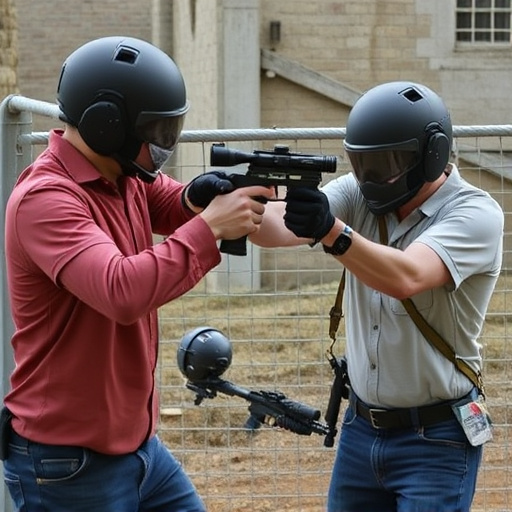Follow immediate decontamination steps after using pepper spray at home: remove contaminated clothing, wash hands thoroughly, rinse eyes with clean water for 15 minutes, and clean pepper spray residue from surfaces. Store pepper spray safely, keeping it locked away, in a sealed bag, and checking expiration dates regularly. Understand local laws regarding possession and use, and practice responsible handling and storage to prevent misuse and cross-contamination.
Staying safe while carrying a pepper spray self-defense weapon is paramount. This guide breaks down essential aspects of responsible ownership, from understanding the spray’s composition and potential risks to navigating legal considerations. Learn crucial decontamination steps to take immediately after use to ensure safety within your home environment. Discover best practices for secure storage and accessibility to empower yourself while avoiding accidental exposure or misuse.
- Understanding Pepper Spray Composition and Risks
- Safe Storage and Accessibility at Home
- Immediate decontamination Steps After Use
- Legal Considerations and Responsible Ownership
Understanding Pepper Spray Composition and Risks
Pepper spray, a popular self-defense weapon, is designed to temporarily disable an attacker through ocular and respiratory irritation. However, understanding its composition and associated risks is paramount for safe usage. The active ingredient in pepper spray is capsaicin, derived from chili peppers, which causes a burning sensation when it comes into contact with the eyes, skin, or mucous membranes. While effective, pepper spray can also pose risks, particularly if not handled and stored properly.
To ensure safety and effective decontamination after use, it’s essential to follow specific steps at home. This includes immediately removing any contaminated clothing, washing hands thoroughly with soap and water, and rinsing eyes gently if affected. Pepper spray residue can remain on surfaces; thus, cleaning these areas with a mild detergent is recommended. Proper disposal of used pepper spray containers should also be considered to prevent accidental exposure or misuse by others.
Safe Storage and Accessibility at Home
Safe storage and accessibility are crucial aspects of pepper spray self-defense weapon safety at home. Keep your pepper spray in a secure, locked location, out of reach of children and unauthorized individuals. A high shelf or a lockable drawer is ideal. Additionally, ensure that it’s stored away from heat sources, direct sunlight, and other environmental factors that could compromise its effectiveness.
When not in use, follow proper decontamination steps at home by keeping the spray can in a sealed, plastic bag to prevent cross-contamination. Regularly check the expiration date and replace the pepper spray according to the manufacturer’s guidelines. This ensures your self-defense weapon remains potent and ready when you need it most.
Immediate decontamination Steps After Use
After using pepper spray for self-defense, immediate decontamination steps are crucial to ensure safety and prevent further irritation. Start by moving to a well-ventilated area or outside, if possible, to minimize inhalation of the irritant. Remove any clothing that may have come into contact with the spray, placing them in a sealed plastic bag for later disposal.
Rinse eyes thoroughly with clean water for at least 15 minutes, ensuring all traces of pepper spray are washed away. For facial irritation, gently wipe the affected area with a damp cloth and mild soap. If breathing becomes difficult, seek fresh air immediately and, if symptoms persist, consult medical attention promptly. Always keep a close eye on any potential signs of allergic reaction and ensure you have identified a nearby healthcare facility for quick access in case of emergencies during pepper spray decontamination at home.
Legal Considerations and Responsible Ownership
Before considering pepper spray as a self-defense weapon, it’s crucial to understand the legal considerations in your area. Different regions have varying laws regarding who can possess and carry pepper spray, with age restrictions and specific requirements for registration or licensing often applying. As a responsible owner, you should familiarize yourself with these regulations to avoid legal repercussions.
Additionally, safe storage and decontamination steps at home are essential. Keep pepper spray out of reach of children and unauthorized individuals. Regularly clean and maintain your device according to the manufacturer’s instructions. After each use or when necessary, perform proper decontamination procedures, such as wiping down surfaces and washing skin or clothing with soap and water to prevent cross-contamination. Remember, responsible ownership involves not only knowing the law but also practicing safe handling and storage practices.
Incorporating pepper spray into your self-defense arsenal requires a balanced approach between its powerful capabilities and safety precautions. By understanding the composition, storing it responsibly, and knowing immediate decontamination steps after use, you can effectively utilize pepper spray while minimizing risks. Additionally, staying informed about legal considerations and practicing responsible ownership are paramount to ensuring its safe and lawful deployment. Remember, proper preparation and awareness are key to maintaining your safety and peace of mind. For practical guidance on pepper spray decontamination steps at home, consult trusted resources and experts in the field.
